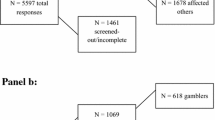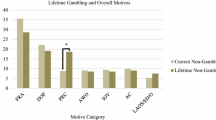Abstract
Today’s college students have grown up with legalized gambling and access to a variety of gambling venues. Compared to the general adult population, rates of disordered gambling among college students are nearly double. Previous research suggests that the desire to win money is a strong motivator to gamble (Neighbors et al. in J Gambl Stud 18:361–370, 2002a); however, there is a dearth of literature on attitudes towards money in relation to gambling behavior. The current study evaluated the association between the four subscales of the Money Attitude Scale (Yamauchi and Templer in J Pers Assess 46:522–528, 1982) and four gambling outcomes (frequency, quantity, consequences and problem severity) in a sample of college students (ages 18–25; N = 2534) using hurdle negative binomial regression model analyses. Results suggest that college students who hold high Power–Prestige or Anxiety attitudes toward money were more likely to gamble and experience greater consequences related to their gambling. Distrust attitudes were negatively associated with gambling behaviors. Retention-Time attitudes were not significantly associated with gambling behaviors and may not be directly relevant to college students, given their often limited fiscal circumstances. These findings suggest that money attitudes may be potential targets for prevention programs in this population.
Similar content being viewed by others
References
American Psychiatric Association, & DSM-5 Task Force. (2013). Diagnostic and statistical manual of mental disorders: DSM-5. Retrieved from http://dsm.psychiatryonline.org/book.aspx?bookid=556. Accessed 10 Dec 2017.
Atkins, D. C., Baldwin, S. A., Zheng, C., Gallop, R. J., & Neighbors, C. (2013). A tutorial on count regression and zero-altered count models for longitudinal substance use data. Psychology of Addictive Behaviors, 27, 166–177.
Blaszczynski, A., & Nower, L. (2002). A pathways model of problem and pathological gambling. Addiction, 97, 487–499. https://doi.org/10.1046/j.1360-0443.2002.00015.x.
Blaszczynski, A., & Nower, L. (2010). Instrumental tool or drug: Relationship between attitudes to money and problem gambling. Addiction Research and Theory, 18(6), 681–691. https://doi.org/10.3109/16066351003786752.
Chen, E. Z., Dowling, N. A., & Yap, K. (2012). An examination of gambling behaviour in relation to financial management behaviour, financial attitudes, and money attitudes. International Journal of Mental Health and Addiction, 10(2), 231–242.
Derevensky, J. L., Gupta, R., Messerlian, C., & Mansour, S. (2009). The impact of gambling advertisements on child and adolescent behaviors: A qualitative analysis. Montreal: McGill University.
Eagan, M. K., Stolzenberg, E. B., Zimmerman, H. B., Aragon, M. C., Whang Sayson, H., & Rios-Aguilar, C. (2017). The American freshman: National norms fall 2016. Los Angeles, CA: Higher Education Research Institute, UCLA.
Fantasy Sports Trade Association. (2017). Industry Demographics Report. Download on 11/17/18 from https://fsta.org/research/industry-demographics/.
Goodie, A. S., MacKillop, J., Miller, J. D., Fortune, E. E., Maples, J., Lance, C. E., et al. (2013). Evaluating the South Oaks gambling screen with DSM-IV and DSM-5 criteria: Results from a diverse community sample of gamblers. Assessment, 20(5), 523–531. https://doi.org/10.1177/1073191113500522.
Gupta, R., & Derevensky, J. L. (1998). Adolescent gambling behavior: A prevalence study and examination of the correlates associated with problem gambling. Journal of Gambling Studies, 14(4), 319–345.
Hilbe, J. (2011). Negative binomial regression (2nd ed.). Cambridge: Cambridge University Press.
Hodgins, D. C., & Makarchuck, K. (2003). Trusting problem gamblers: Reliability and validity of self-reported gambling behavior. Psychology of Addictive Behaviors, 17(3), 244–248.
Hogg, M., & Vaughan, G. (2005). Social Psychology (4th ed.). London: Prentice-Hall.
Hussar, W. J., & Bailey, T. M. (2017). Projections of education statistics to 2025 (NCES 2017-019). Washington, DC: U.S. Department of Education, National Center for Education Statistics.
IBM Corp. (2010). IBM SPSS statistics for windows, version 19.0. Armonk: IBM Corp.
Kim, H. S., & Hodgins, D. C. (2017). Reliability and validity of data obtained from alcohol, cannabis, and gambling populations on Amazon’s Mechanical Turk. Psychology of Addictive Behaviors, 31(1), 85–94. https://doi.org/10.1037/adb0000219.
Lesieur, H. R., & Blume, S. B. (1987). The South Oaks gambling screen (SOGS): A new instrument for the identification of pathological gamblers. American Journal of Psychiatry, 144(9), 1184–1188.
Lostutter, T. W., Lewis, M. A., Cronce, J. M., Neighbors, C., & Larimer, M. E. (2014). The use of protective behaviors in relation to gambling among college students. Journal of Gambling Studies, 30(1), 27–46. https://doi.org/10.1007/s10899-012-9343-8.
Marchica, L., & Derevensky, J. (2016). Fantasy sports: A growing concern among college student-athletes. International Journal of Mental Health and Addiction, 14(5), 635–645. https://doi.org/10.1007/s11469-015-9610-x.
Neighbors, C., Lostutter, T. W., Cronce, J. M., & Larimer, M. E. (2002a). Exploring college student gambling motivation. Journal of Gambling Studies, 18, 361–370.
Neighbors, C., Lostutter, T. W., Larimer, M. E., & Takushi, R. Y. (2002b). Measuring gambling outcomes among college students. Journal of Gambling Studies, 18(4), 339–360. https://doi.org/10.1023/A:1021013132430.
Nowak, D. E. (2017). A meta-analytical synthesis and examination of pathological and problem gambling rates and associated moderators among college students, 1987–2016. Journal of Gambling Studies, Published online: October 20, 2017. https://doi.org/10.1007/s10899-017-9726-y.
Nowak, D. E., & Aloe, A. M. (2014). The prevalence of pathological gambling among college students: A meta-analytic synthesis, 2005–2013. Journal of Gambling Studies, 30(4), 819–843. https://doi.org/10.1007/s10899-013-9399-0.
Nower, L., & Blaszczynski, A. (2010). Gambling motivations, money-limiting strategies, and precommitment preferences of problem versus non-problem gamblers. Journal of Gambling Studies, 26(3), 361–372.
Pabst, A., Kraus, L., Piontek, D., Mueller, S., & Demmel, R. (2014). Direct and indirect effects of alcohol expectancies on alcohol-related problems. Psychology of Addictive Behaviors, 28(1), 20–30. https://doi.org/10.1037/a0031984.
Petry, N. M., Ginley, M. K., & Rash, C. J. (2017). A systematic review of treatments for problem gambling. Psychology of Addictive Behaviors, 31(8), 951–961. https://doi.org/10.1037/adb0000290.
R Core Team. (2013). R: A language and environment for statistical computing. R Foundation for Statistical Computing, Vienna, Austria. http://www.R-project.org/. Accessed 5 Dec 2017.
Roberts, J. A., & Jones, E. (2001). Money attitudes, credit card use, and compulsive buying among American college students. Journal of Consumer Affairs, 35(2), 213–240. https://doi.org/10.1111/j.1745-6606.2001.tb00111.x.
Shaffer, H. J., Hall, M. N., & Vanderbilt, J. (1999). Estimating the prevalence of disordered gambling behavior in the United States and Canada: A research synthesis. American Journal of Public Health, 89(9), 1369–1376. https://doi.org/10.2105/AJPH.89.9.1369.
Stinchfield, R. (2002). Reliability, validity, and classification accuracy of the South Oaks gambling screen. Addictive Behaviors, 27, 1–19.
Tang, T. L. P. (1992). The meaning of money revisited. Journal of Organizational Behavior, 13, 197–202.
Welte, J. W., Barnes, G. M., Tidwell, M.-C. O., Hoffman, J. H., & Wieczorek, W. F. (2015). Gambling and problem gambling in the United States: Changes between 1999 and 2013. Journal of Gambling Studies, 31(3), 695–715. https://doi.org/10.1007/s10899-014-9471-4.
Yamauchi, K., & Templer, D. (1982). The development of a money attitude scale. Journal of Personality Assessment, 46, 522–528.
Funding
This research was supported in part by Grants from the National Institute on Drug Abuse F31DA023634 awarded to Ty W. Lostutter, and joint funding received from Evergreen Council on Problem Gambling and Washington State’s Division of Behavioral Health and Recovery. Manuscript preparation was also support by National Institute on Alcohol Abuse and Alcoholism Grant T32AA007455-27 awarded to Mary E. Larimer, National Institute on Drug Abuse Grant F31DA042503 award to Matthew Enkema; National Institute on Alcohol Abuse and Alcoholism Grants F31AA02553 and K01AA016966 awarded to Frank Schwebel and Melissa A. Lewis, respectively. The content is solely the responsibility of the authors and does not necessarily represent the official views of any of the funding agencies.
Author information
Authors and Affiliations
Corresponding author
Ethics declarations
Conflict of interest
The authors do not have any conflict of interest to report.
Ethical Approval
All procedures performed in studies involving human participants were in accordance with the ethical standards of the institutional and/or national research committee and with the 1964 Helsinki declaration and its later amendments or comparable ethical standards.
Rights and permissions
About this article
Cite this article
Lostutter, T.W., Enkema, M., Schwebel, F. et al. Doing It for the Money: The Relationship Between Gambling and Money Attitudes Among College Students. J Gambl Stud 35, 143–153 (2019). https://doi.org/10.1007/s10899-018-9789-4
Published:
Issue Date:
DOI: https://doi.org/10.1007/s10899-018-9789-4




